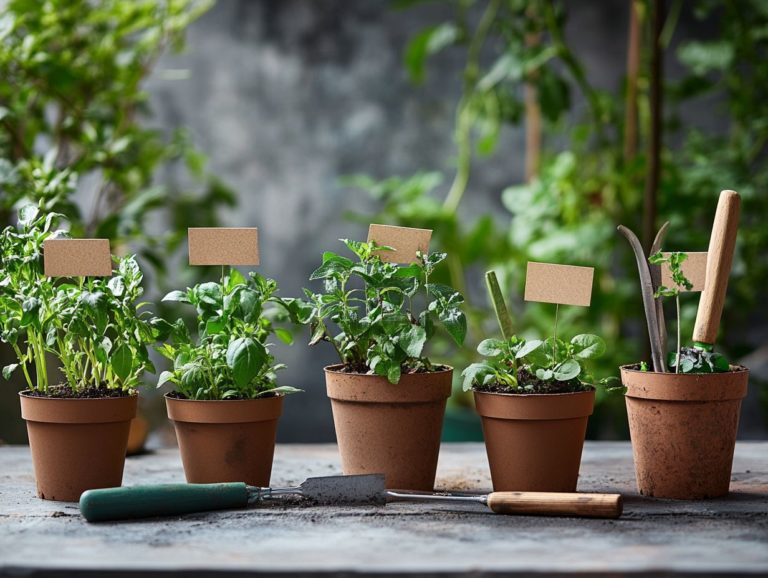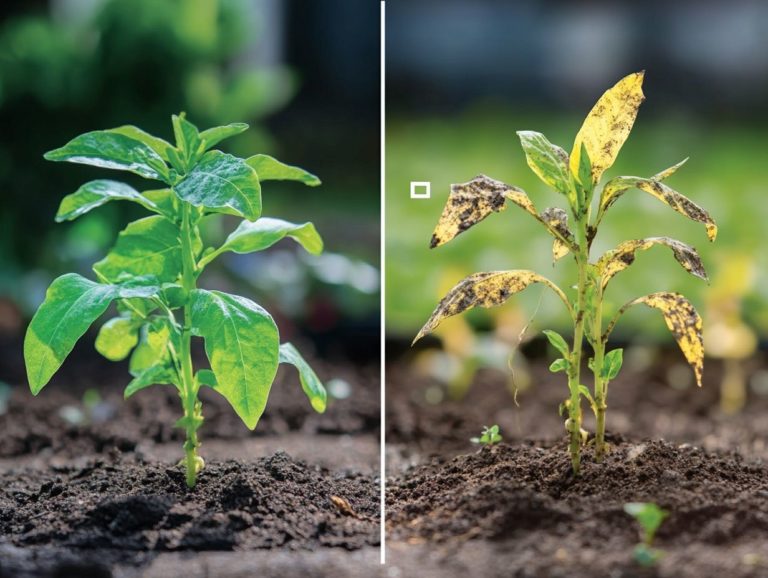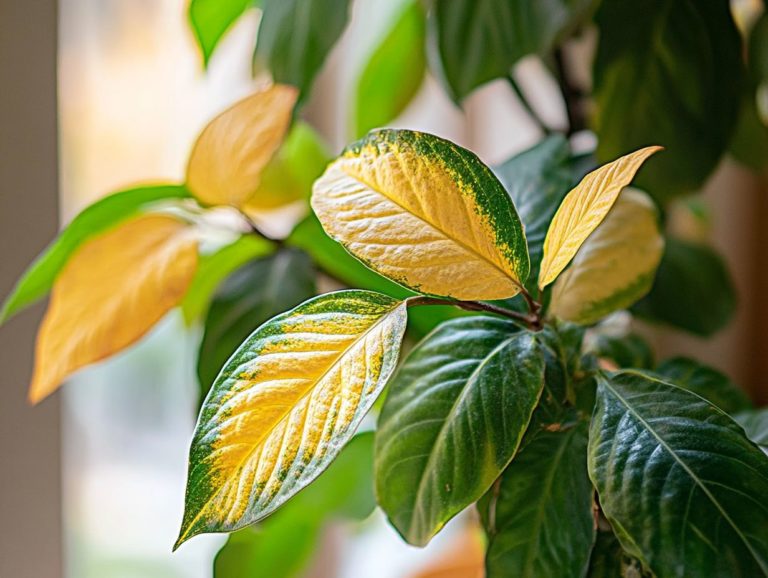How to Diagnose Indoor Plant Health Issues
Indoor plants can infuse your home with vibrant life, yet they often encounter health challenges that leave them looking less than their best.
Recognizing the signs of distress is essential for any plant enthusiast like yourself.
This guide will illuminate common indoor plant health issues, empowering you to identify problems, diagnose them through various tools and techniques, and explore effective remedies.
You will also learn tips to prevent future problems, ensuring that your leafy companions flourish for years to come.
Contents
- Key Takeaways:
- Common Indoor Plant Health Issues
- Diagnosing Plant Health Issues
- How to Address and Treat Plant Health Issues
- Preventing Indoor Plant Health Issues
- Frequently Asked Questions
- What are some common signs of indoor plant health issues?
- How can I tell if my indoor plant is receiving enough sunlight?
- What are some reasons why my indoor plant might be wilting?
- What is the best way to check for pests on my indoor plants?
- How can I prevent indoor plant health issues?
- What should I do if my indoor plant is showing signs of disease?
Key Takeaways:
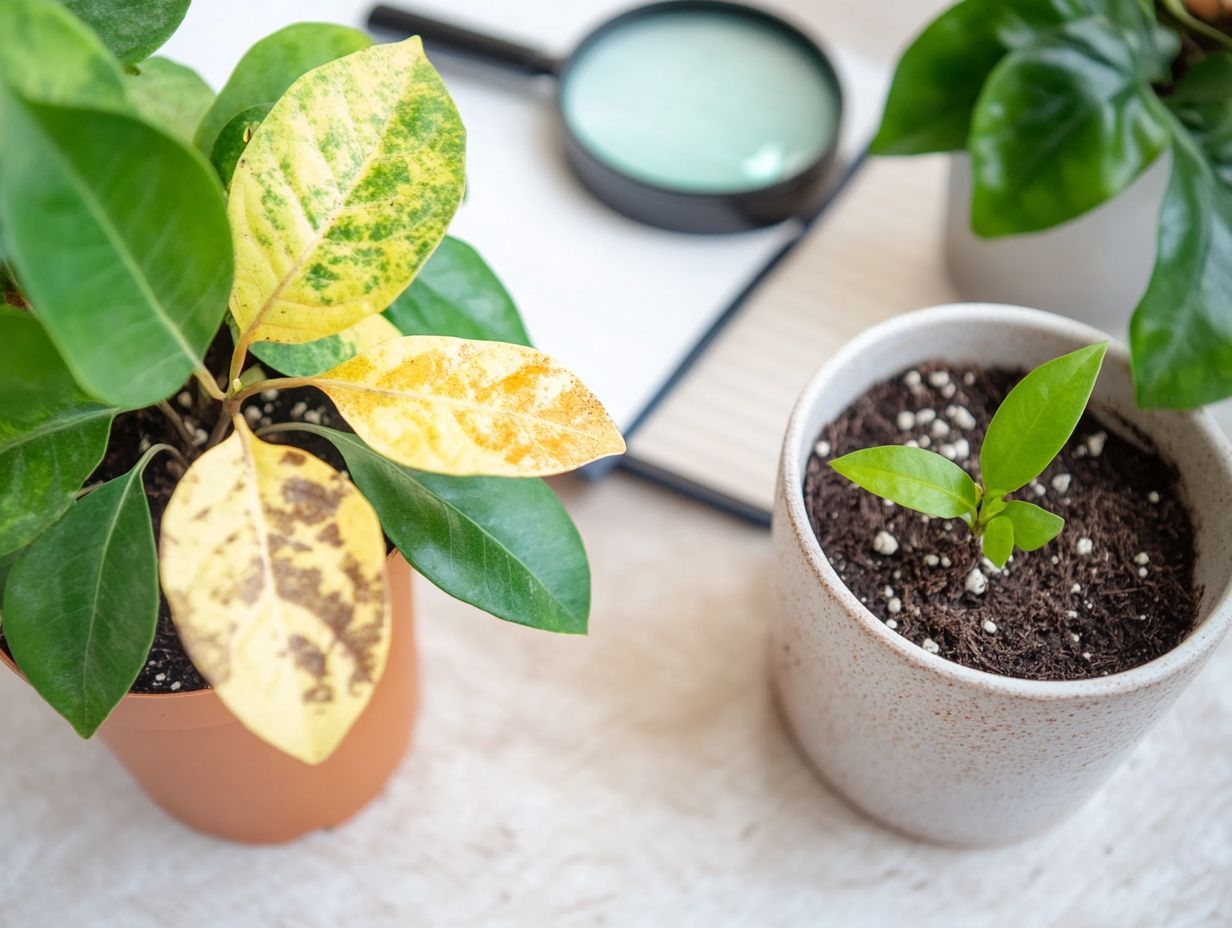
- Identify the problem: Look for signs of common indoor plant health issues such as discoloration, wilting, and pests to accurately diagnose the problem.
- Use the right tools and techniques: A magnifying glass, pH meter, and water moisture meter can help pinpoint the issue and determine the best course of action.
- Prevention is key: Regularly inspect and care for your indoor plants to prevent health issues, such as proper watering and providing adequate light and air circulation.
Common Indoor Plant Health Issues
Indoor plants, like Ficus and other beloved houseplants, frequently encounter a host of health challenges that can jeopardize their growth and health. You may notice symptoms such as yellowing leaves, dropping foliage, and distorted growth.
These issues can arise from various factors, including insufficient sunlight, low humidity, and pest infestations. Understanding these issues is essential for accurately diagnosing and addressing indoor plant concerns. Additionally, knowing how to test soil quality for indoor plants ensures that you can effectively treat them and prevent future complications.
Identifying the Problem
Identifying the specific issues affecting your indoor plants is crucial for providing the right treatment and care. Common symptoms like dropping leaves, yellowing new growth, and distorted shapes can signal various underlying problems, such as pest infestations or improper light exposure.
Pay attention to changes in leaf color and the condition of the foliage. For example, if you notice brown, crispy edges, it might indicate underwatering or low humidity levels. Conversely, spots or patches could point to fungal infections or pest damage. To ensure healthy plants, it’s also important to understand how to identify and treat soil of indoor plants.
By regularly examining your plants, you can catch these symptoms early, allowing for timely intervention before problems escalate. A proper diagnosis not only enhances the health of your green companions but also creates a more vibrant indoor environment, ensuring your plants thrive and flourish in their surroundings. Additionally, learning how to maintain soil health for indoor plants can further support their growth.
Diagnosing Plant Health Issues
Diagnosing plant health issues is essential. Look at factors like sunlight, soil, and moisture to keep your plants thriving. You’ll want to consider elements such as sunlight exposure, soil conditions, and moisture levels.
Using tools like a moisture meter, which measures soil moisture levels, can be invaluable in determining whether overwatering or root rot is at play in your plant’s decline. Additionally, assessing air circulation can help uncover potential issues related to fungal diseases or pest infestations. Being aware of the signs of nutrient deficiency in indoor plants is also crucial for maintaining their health.
Tools and Techniques
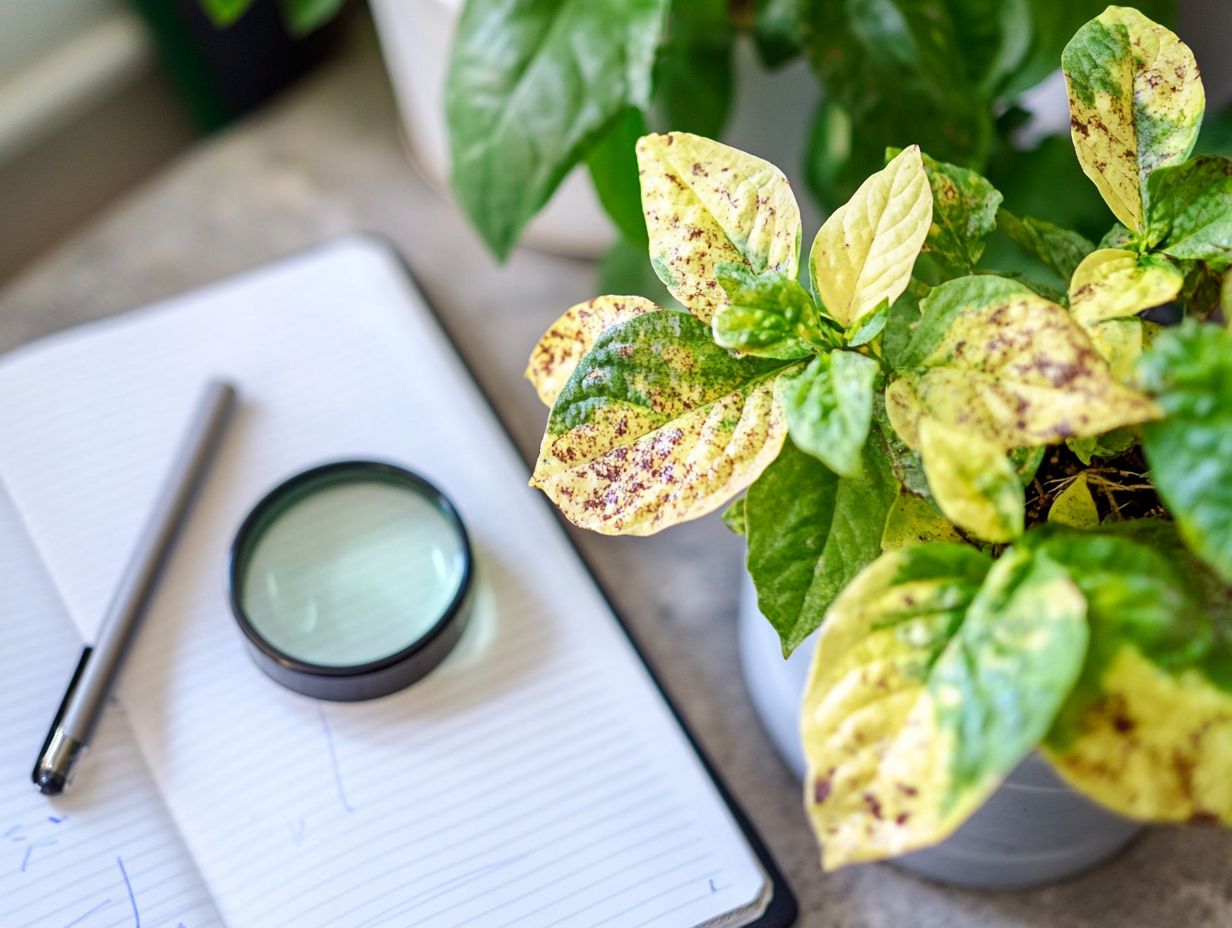
Using the right tools and techniques is essential for maintaining healthy indoor plants. A moisture meter will be your best friend, helping you accurately gauge soil moisture levels. Products like insecticidal soap and neem oil effectively combat common pests like aphids and spider mites.
Establishing a consistent watering routine is crucial; it prevents both overwatering and underwatering two common pitfalls that can stress your plants. Regularly pruning infected leaves not only enhances the plant’s appearance but also curbs the spread of pests and diseases.
By integrating these methods, you can cultivate a thriving indoor ecosystem where your plants flourish and resist harmful invaders, ensuring lush greenery and vibrant blooms all year round.
How to Address and Treat Plant Health Issues
Addressing and treating plant health issues requires a proactive approach. It involves effective solutions and remedies tailored to the specific challenges your houseplants face.
For example, using insecticidal soap or neem oil can be a game changer in combating pest infestations. Targeted treatments may be necessary for fungal diseases like gray mold and powdery mildew.
By applying these focused strategies, you can ensure your plants thrive in a healthy environment.
Top Solutions to Keep Your Plants Healthy
Implementing effective solutions is essential for restoring the health of your indoor plants. When dealing with pesky fungus gnats small flies that can damage plants employ varied methods.
Adjusting your watering routine and pruning infected leaves can help prevent further damage. Regularly check your plants for early signs of distress, like yellowing leaves or webbing.
Utilizing natural repellents and maintaining optimal humidity levels effectively deters pests from making your plants their home. These small changes foster a healthy environment that promotes robust growth.
By keeping a close eye on your plants, you can catch potential issues early and support their growth!
Preventing Indoor Plant Health Issues
To maintain a thriving indoor plant collection, it s crucial to prevent health issues. Understand the factors that contribute to plant stress and vulnerability.
Focus on ensuring adequate humidity levels, establishing consistent watering practices, providing optimal light exposure, and promoting proper air circulation. Attend to these aspects to create a nurturing environment for your plants well-being.
Tips for Maintaining Healthy Plants

Maintaining healthy indoor plants requires your diligence and commitment to best practices. Strategies such as increasing humidity, establishing a consistent watering routine, and ensuring proper air circulation are essential.
Regularly check the moisture levels in the soil. Adjust your watering schedule based on the specific needs of each plant.
For example, certain species thrive in humid conditions, so you might consider using a humidifier or pebble trays to create a more inviting atmosphere. Look out for early signs of stress, like drooping leaves or discoloration.
By implementing these impactful changes, you can cultivate a thriving indoor garden. This not only enhances the beauty of your space but also brings a sense of tranquility into your home.
Frequently Asked Questions
What are some common signs of indoor plant health issues?
Common signs include wilting, yellowing or browning leaves, stunted growth, and pest infestations.
How can I tell if my indoor plant is receiving enough sunlight?
If your plant is not receiving enough sunlight, its leaves may become pale or spindly. If it is getting too much sunlight, leaves may turn brown or wilt.
What are some reasons why my indoor plant might be wilting?
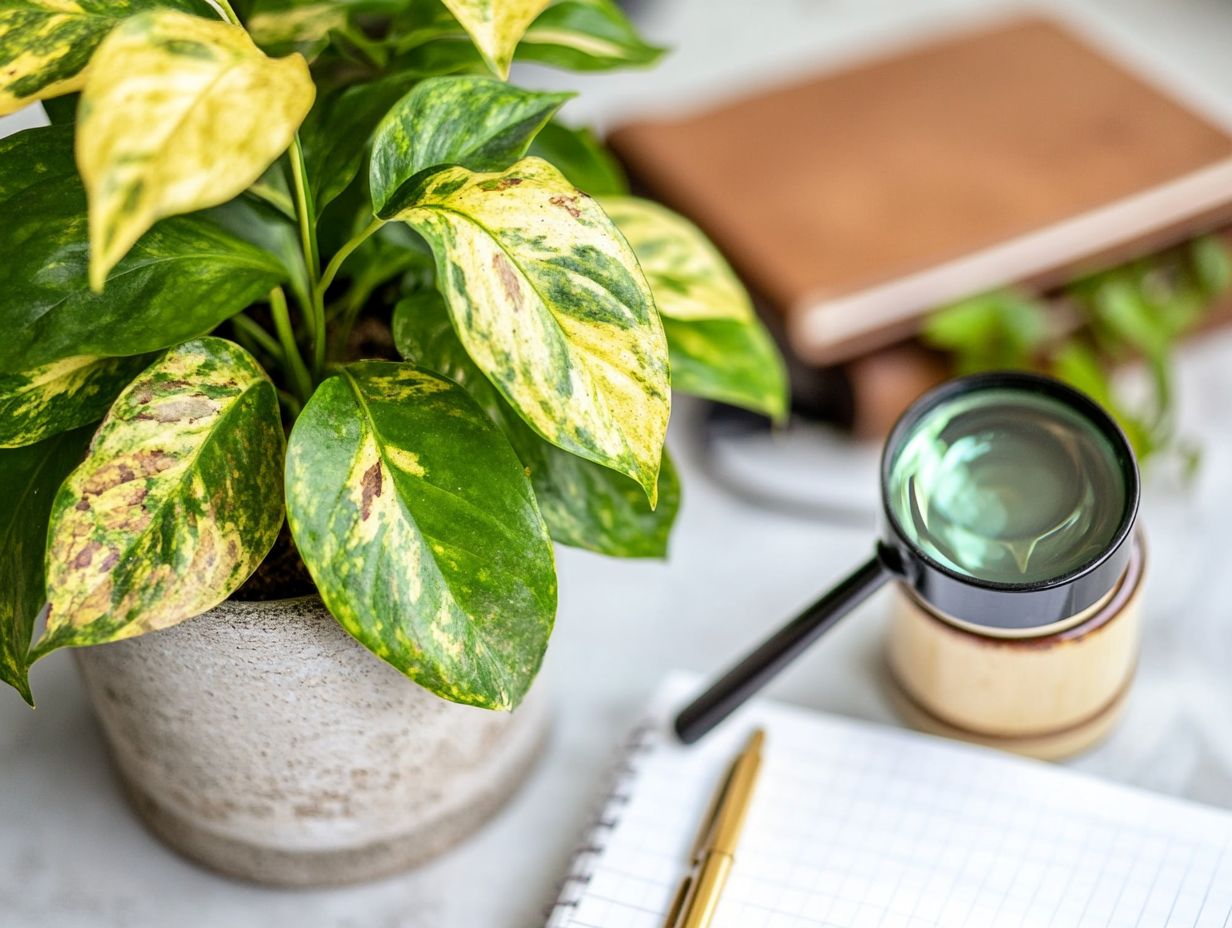
Wilting can occur due to a lack of water, overwatering, root rot (when roots decay due to excess wetness), or pests. It may also indicate too little or too much sunlight.
What is the best way to check for pests on my indoor plants?
The best way to check for pests is to inspect the leaves, stems, and soil. Look for visible bugs, webs, or signs of damage.
Gently shake the plant over a white piece of paper to see if any pests fall out. This can help you identify any hidden issues.
How can I prevent indoor plant health issues?
To keep your indoor plants healthy, ensure they get enough water, sunlight, and nutrients. Regularly check for pests and diseases, and act quickly if you find any.
Cleaning and dusting your plants is also essential. This simple step can greatly enhance their health.
What should I do if my indoor plant is showing signs of disease?
If you notice your plant has yellow or spotted leaves, isolate it immediately. This helps prevent the disease from spreading to your other plants.
You can consult a plant expert or research online to identify the issue. Knowing the specific disease will guide you in choosing the best treatment.


